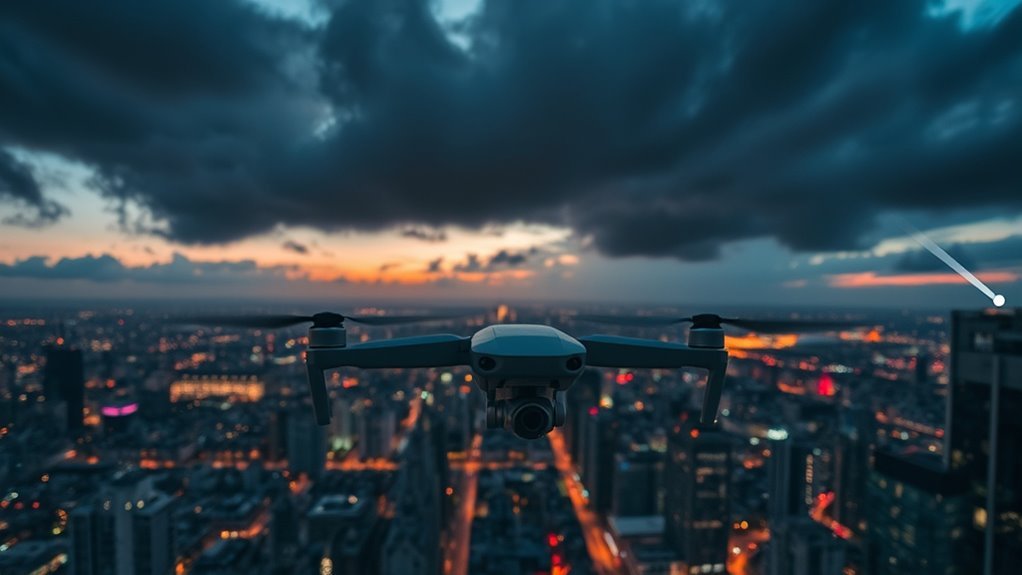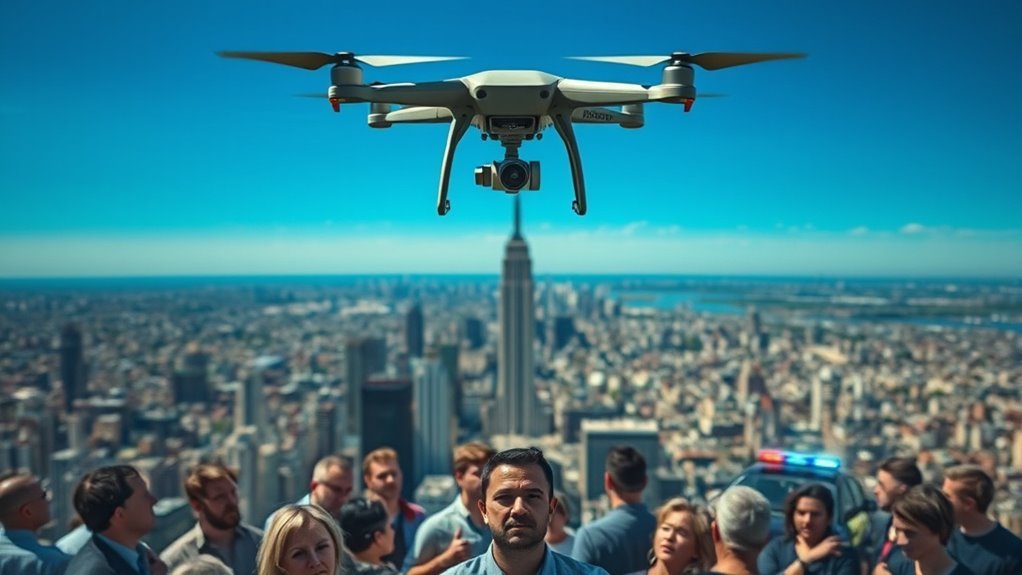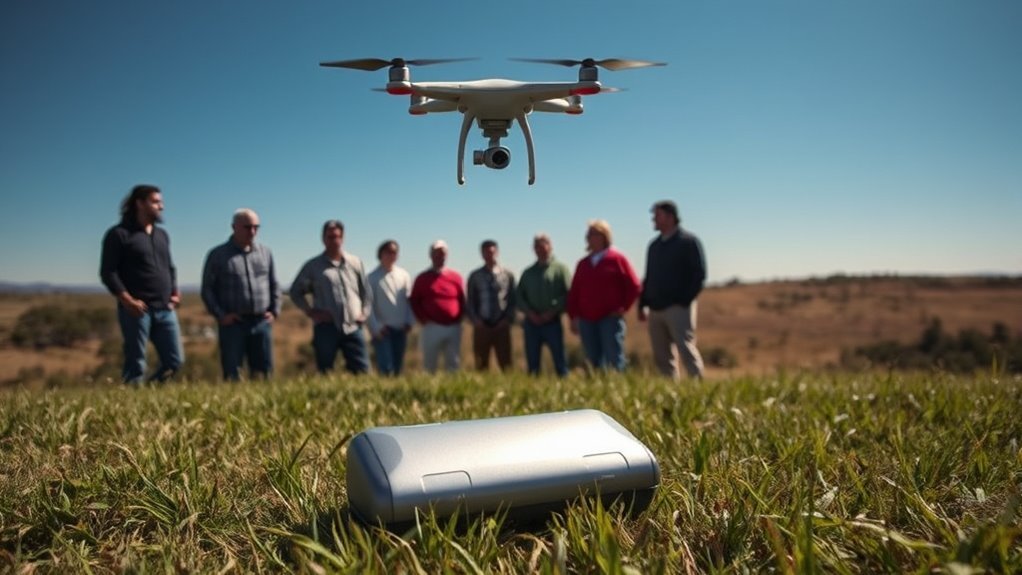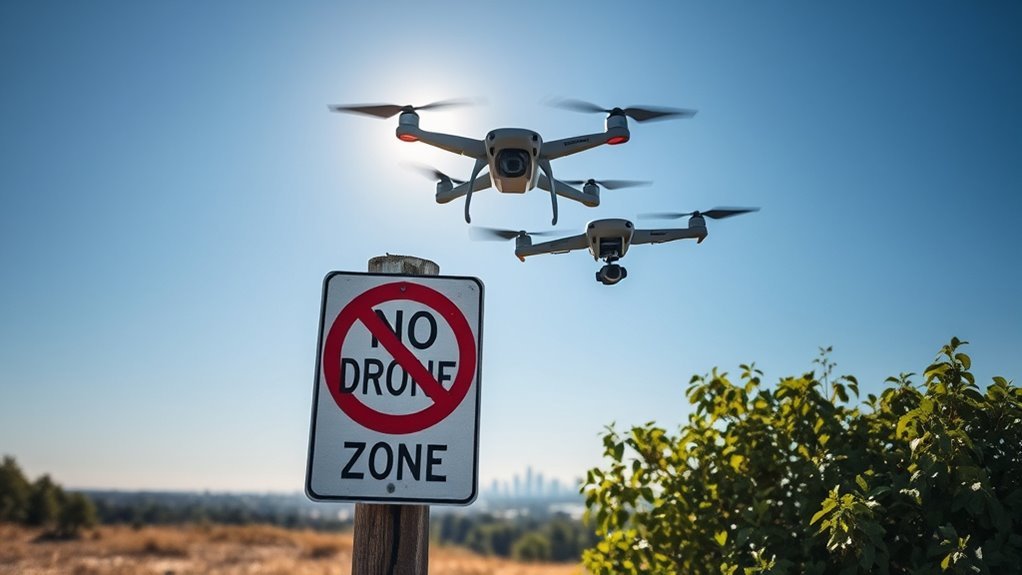Engaging in drone jamming activities can lead to serious legal implications. Both federal and state regulations prohibit unauthorized signal interference, exposing you to potential criminal charges and civil liabilities. The Federal Communications Commission (FCC) strictly governs airspace usage, and state laws may impose additional restrictions. Violating these regulations could result in fines or even jail time. Understanding the complexities of these legal frameworks is essential for anyone considering jamming technology, which is why exploring further details is important.
Understanding Drone Jamming: Definition and Mechanisms

Although drone technology has advanced rapidly, the need for effective countermeasures like drone jamming has become increasingly critical. Jamming technology works by emitting signals that interfere with a drone’s communication systems, disrupting its ability to receive commands or transmit data. This signal interference effectively neutralizes the drone’s operational capabilities, providing a means to counter unauthorized surveillance or malicious activities. In practice, you’ll find that jammers operate across various frequencies, targeting specific protocols used by drones. Understanding the mechanisms behind drone jamming is essential for anyone concerned about privacy and security. While it offers a tactical advantage, the implications of deploying such technology raise questions about legality and ethical use, especially in contexts where personal freedom and rights are at stake.
Regulatory Framework Governing Drone Operations

To understand the regulatory framework governing drone operations, you’ll need to take into account both Federal Aviation Administration regulations and the various state and local laws that apply. These regulations dictate operational parameters, safety standards, and airspace management, while local laws may impose additional restrictions. Steering through this complex landscape is essential for ensuring compliance and mitigating legal risks associated with drone activities.
Federal Aviation Administration Regulations
When it comes to drone operations, understanding the Federal Aviation Administration (FAA) regulations is essential for compliance and safety. The FAA governs the use of drone technology to guarantee that operations don’t interfere with manned aircraft and public safety. You’ll need to familiarize yourself with Part 107, which outlines rules for commercial drone use, including pilot certification and operational limitations. Additionally, the FAA strictly prohibits signal interference, which can disrupt communication and navigation systems. Violating these regulations can result in severe penalties, including fines and loss of flying privileges. Staying informed about the FAA’s evolving framework not only enhances your operational freedom but also safeguards against legal complications that could arise from non-compliance.
State and Local Laws
Understanding FAA regulations is just one aspect of maneuvering the complex landscape of drone operations. You must also navigate a patchwork of state regulations and local ordinances that can greatly impact your freedom to operate drones. States may impose additional rules regarding where you can fly, often restricting operations near schools, parks, or essential infrastructure. Local municipalities might have their own specific ordinances that dictate flight times or require permits for drone use. Ignoring these regulations can lead to legal repercussions, including fines or confiscation of your equipment. It’s vital to stay informed about these laws in your jurisdiction to guarantee compliance while preserving your operational liberties. Always check the current legal framework before launching your drone.
Legal Consequences of Jamming Drone Signals

When you jam drone signals, you’re potentially violating federal regulations that govern airspace use. This can lead to serious criminal charges, as it interferes with lawful operations and safety protocols. Additionally, you could face civil liability risks if your actions result in damages or injuries.
Federal Regulations Overview
Although the allure of jamming drone signals might seem appealing for privacy or security reasons, it’s essential to recognize the stringent federal regulations governing such activities. Engaging in jamming can lead to severe consequences under the law, as it violates federal statutes designed to protect communications integrity.
- The Federal Communications Commission (FCC) strictly prohibits any unauthorized signal interference.
- Jamming drone technology not only disrupts commercial operations but also poses safety risks.
- Ethical considerations regarding jamming practices can lead to complex legal dilemmas concerning personal freedoms.
Understanding these regulations is vital for anyone considering jamming activities, as the legal landscape surrounding drone technology is both intricate and ever-evolving. Always weigh your actions against the principles of jamming ethics and the potential repercussions.
Potential Criminal Charges
Engaging in jamming drone signals can lead to serious criminal charges under federal law. This activity often involves the use of jamming technology, which disrupts legitimate communications and poses significant risks to public safety. If you’re found guilty, you could face charges based on criminal intent, as the law considers your purpose in deploying such technology. Intentional disruption of drone operations can result in penalties, including hefty fines and potential imprisonment. Federal agencies, like the FCC, actively pursue individuals who engage in these actions, viewing them as threats to navigational safety and security. As a result, exercising caution and understanding the legal framework is vital if you’re considering any form of signal jamming.
Civil Liability Risks
While jamming drone signals may seem like a harmless act, it can expose you to significant civil liability risks. Engaging in such activities could lead to legal consequences that extend beyond mere fines. You might face claims for damages from drone operators or property owners affected by your actions. Here are some potential civil liability considerations:
- Negligence: If your jamming disrupts emergency services or vital operations, you could be held liable for negligence.
- Property Damage: Jamming signals can inadvertently cause damage to others’ equipment, leading to costly claims.
- Insurance Coverage: Many insurance policies exclude coverage for illegal activities, leaving you unprotected against liability claims.
Understanding these risks is essential before you decide to engage in jamming activities.
Federal Communications Commission (FCC) Regulations
As the use of drones proliferates, understanding the Federal Communications Commission (FCC) regulations becomes essential for operators to guarantee compliance and avoid legal repercussions. The FCC regulates electromagnetic spectrum use, important for drone operations. Engaging in drone interference, such as jamming signals, can violate these regulations, leading to significant penalties. You must recognize that the FCC prohibits unauthorized transmission, which extends to any activities that disrupt communication signals. Violations may result in hefty fines or criminal charges. To operate within the law, familiarize yourself with the specific emissions standards and operational limitations outlined by FCC regulations. Adhering to these guidelines is critical for maintaining the integrity of airspace and ensuring your freedom to operate drones responsibly.
State Laws and Local Ordinances Related to Drone Jamming
Although the FCC sets federal guidelines, state laws and local ordinances can impose additional restrictions on drone jamming activities, complicating the legal landscape for operators. It’s vital to understand how state regulations and local ordinances may differ markedly from federal standards, potentially leading to severe legal consequences.
- Some states may outright ban drone jamming devices, regardless of federal allowances.
- Local jurisdictions might enforce specific usage limitations or licensing requirements for jamming technology.
- Violating state or local laws could result in fines or criminal charges, emphasizing the need for thorough legal research.
Navigating these complexities demands vigilance to guarantee compliance and protect your freedom to operate. Always consult legal counsel familiar with both federal and local regulations before engaging in jamming activities.
Case Studies: Legal Precedents in Drone Jamming
Understanding the legal precedents surrounding drone jamming is essential for anyone considering its use, since these cases can illuminate how courts interpret existing laws. Below is a summary of notable case analyses that highlight different legal outcomes involving drone jamming.
| Case Name | Year | Legal Outcome |
|---|---|---|
| U.S. v. Drone Co. | 2018 | Jamming deemed unlawful |
| State v. Operator | 2019 | Operator fined for jamming |
| FAA v. Individual | 2020 | Jamming led to criminal charges |
| Tech Corp v. State | 2021 | Court ruled in favor of jamming for security |
These cases show the spectrum of legal interpretations and underscore the implications of unauthorized drone interference. Understanding these outcomes can guide your decisions regarding drone jamming activities.
Implications for Public Safety and Privacy Rights
While the use of drone jamming technology may be perceived as a necessary measure for enhancing security, it raises significant concerns regarding public safety and privacy rights. You should consider the potential implications:The implementation of drone jamming technology poses serious questions about public safety and the protection of privacy rights.
- Risk of accidents: Jamming signals could interfere with legitimate drones, leading to crashes that endanger nearby individuals.
- Privacy invasion: The technology may inadvertently disrupt personal devices, raising questions about unauthorized interference with private communications.
- Chilling effect on freedom: Excessive jamming could deter individuals from using drones for legitimate purposes, infringing on their rights to innovate and explore.
Ultimately, while aiming to protect public safety, you must weigh these risks against the potential for privacy invasion and the impact on personal freedoms. Balancing security and rights is essential in this evolving technological landscape.
The Role of Law Enforcement in Drone Jamming Incidents
As drone jamming incidents become more prevalent, law enforcement agencies must navigate the complex legal framework surrounding their involvement. Your understanding of law enforcement roles in jamming enforcement is essential. They’re often tasked with responding to unauthorized jamming activities that can disrupt public safety and airspace security. However, the legal boundaries are murky; agencies must balance the need for effective enforcement with the rights of individuals. This includes adhering to federal regulations that govern radio frequency usage. Missteps can lead to civil liabilities or criminal charges against enforcement personnel. Consequently, it’s imperative for law enforcement to be well-informed about legal implications while actively pursuing jamming enforcement strategies that respect personal freedoms and uphold public safety.
Navigating Compliance and Best Practices for Drone Operators
To guarantee compliance and mitigate risks, drone operators must familiarize themselves with the complex regulatory landscape governing UAV activities. Understanding the legal framework is vital, especially in relation to drone technology and signal interference, which can lead to significant liabilities.
Consider these best practices:
- Stay Informed: Regularly review updates from aviation authorities regarding drone regulations and best practices.
- Implement Safety Protocols: Establish operational guidelines that minimize the risk of signal interference with other devices and guarantee safe flight paths.
- Maintain Equipment: Regularly inspect and maintain your drone to guarantee it operates within regulatory standards, minimizing the chance of technical failures.
Adhering to these practices not only promotes safe drone operation but also protects your rights and freedoms as an operator.
Frequently Asked Questions
Can Individuals Legally Jam Drones on Their Private Property?
You can’t legally jam drones on your private property. Drone interference laws restrict such actions, despite private property rights. It’s essential to understand these regulations to avoid potential legal repercussions while asserting your rights.
What Are the Penalties for Unauthorized Drone Jamming?
Engaging in unauthorized drone jamming carries significant penalties, often involving hefty fines or even potential imprisonment. The consequences of drone interference can severely impact your freedom, so it’s wise to tread carefully in these matters.
Are There Exceptions for Emergency Services to Jam Drones?
You’ll find that emergency exemptions for jamming drones exist, primarily aimed at protecting public safety. However, these exceptions are tightly regulated, requiring clear justification to prevent misuse and guarantee accountability in critical situations.
How Does Drone Jamming Affect Air Traffic and Aviation Safety?
Drone jamming’s like a storm in the skies; it can cause severe drone interference, complicating aviation regulations. This disruption poses risks to air traffic, potentially endangering safety and the freedom of movement in our airspace.
Can Drone Manufacturers Be Held Liable for Jamming-Related Incidents?
You might consider that manufacturers can face liability for incidents involving their jamming technology, especially if it’s proven that their products contributed to unsafe conditions. Understanding manufacturer responsibility is essential for ensuring accountability in drone operations.

